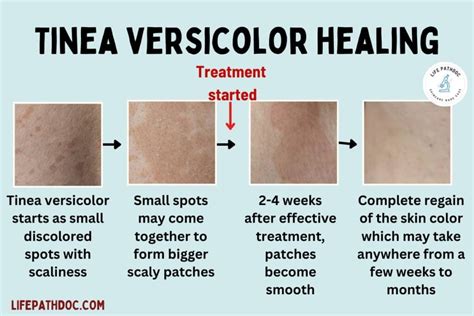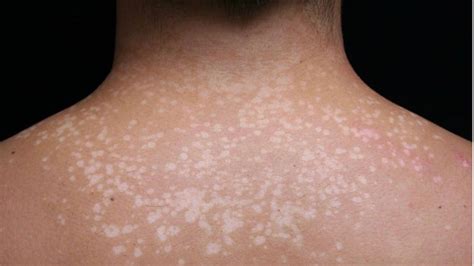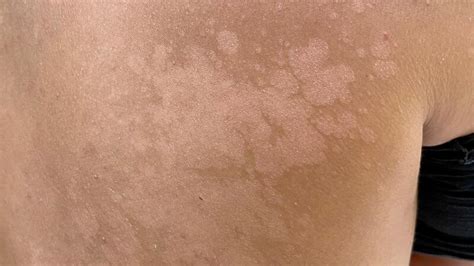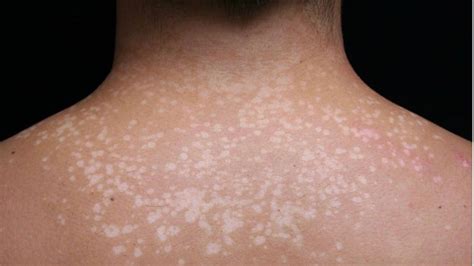Intro
Discover Tinea Versicolor causes, symptoms, and treatments. Learn about fungal infections, skin discoloration, and yeast imbalance, to manage this common skin condition effectively.
Tinea versicolor is a common skin condition that affects millions of people worldwide. It is characterized by the appearance of discolored patches on the skin, which can be lighter or darker than the surrounding skin tone. The condition is often accompanied by a scaly, itchy, or flaky texture, and can be quite embarrassing for those who suffer from it. Despite its prevalence, tinea versicolor remains a poorly understood condition, and many people are unaware of its causes and risk factors.
The importance of understanding tinea versicolor causes cannot be overstated. By knowing what triggers the condition, individuals can take steps to prevent its occurrence or reduce its severity. Furthermore, recognizing the risk factors associated with tinea versicolor can help people take proactive measures to protect their skin health. In this article, we will delve into the world of tinea versicolor, exploring its causes, symptoms, and treatment options. Whether you are a sufferer of this condition or simply interested in learning more, this article aims to provide you with a comprehensive understanding of tinea versicolor.
Tinea versicolor is a complex condition that is influenced by a combination of genetic, environmental, and lifestyle factors. While the exact causes of the condition are still not fully understood, research has identified several key contributors. These include the overgrowth of a type of yeast called Malassezia, which is naturally found on the skin, as well as factors such as warm weather, humidity, and oily skin. By understanding these causes, individuals can take steps to reduce their risk of developing tinea versicolor and improve their overall skin health.
Tinea Versicolor Causes and Risk Factors

Tinea versicolor is caused by the overgrowth of Malassezia yeast on the skin. This yeast is naturally found on the skin and plays a role in breaking down oils. However, when it grows out of control, it can lead to the development of tinea versicolor. Several factors can contribute to the overgrowth of Malassezia, including warm weather, humidity, and oily skin. People who live in tropical or subtropical regions, or who engage in activities that cause excessive sweating, are more likely to develop tinea versicolor.
Genetic Predisposition
Research has shown that genetic predisposition can play a role in the development of tinea versicolor. Some people may be more susceptible to the condition due to their genetic makeup, which can affect the way their skin responds to Malassezia yeast. Additionally, people with certain medical conditions, such as diabetes or immune system disorders, may be more likely to develop tinea versicolor.Symptoms and Diagnosis

The symptoms of tinea versicolor can vary from person to person, but they often include the appearance of discolored patches on the skin. These patches can be lighter or darker than the surrounding skin tone and may be accompanied by a scaly, itchy, or flaky texture. In some cases, the condition can cause redness, inflammation, or blistering. Diagnosing tinea versicolor typically involves a physical examination and a review of the patient's medical history. A doctor may also use a Wood's lamp to examine the skin, as the patches may glow yellow or copper under the light.
Treatment Options
Fortunately, tinea versicolor is a treatable condition, and several options are available to help manage its symptoms. Topical antifungal medications, such as creams or ointments, are often used to treat the condition. In more severe cases, oral antifungal medications may be prescribed. Additionally, people with tinea versicolor can take steps to prevent the condition from recurring, such as using anti-dandruff shampoos, reducing sweat and oil production, and avoiding tight clothing.Prevention and Self-Care

Preventing tinea versicolor requires a combination of self-care and lifestyle modifications. People who are prone to the condition can take steps to reduce their risk by keeping their skin clean and dry, wearing loose-fitting clothing, and avoiding excessive sweating. Additionally, using anti-dandruff shampoos or medicated cleansers can help to control the growth of Malassezia yeast.
Lifestyle Modifications
Making lifestyle modifications can also help to prevent tinea versicolor. This includes avoiding tight clothing, reducing stress, and getting regular exercise. Additionally, people who are prone to the condition can try to reduce their exposure to warm weather and humidity, which can contribute to the overgrowth of Malassezia yeast.Tinea Versicolor and Skin Health

Tinea versicolor can have a significant impact on skin health, particularly if left untreated. The condition can cause discomfort, itching, and inflammation, which can lead to secondary infections or scarring. Furthermore, tinea versicolor can affect a person's self-esteem and quality of life, particularly if the condition is severe or widespread.
Complications and Secondary Infections
In rare cases, tinea versicolor can lead to complications or secondary infections. These can include bacterial or fungal infections, which can require additional treatment. Additionally, people with tinea versicolor may be more susceptible to other skin conditions, such as acne or eczema.Tinea Versicolor in Different Populations

Tinea versicolor can affect people of all ages and backgrounds, but it is more common in certain populations. For example, people who live in tropical or subtropical regions are more likely to develop the condition due to the warm weather and humidity. Additionally, people with certain medical conditions, such as diabetes or immune system disorders, may be more susceptible to tinea versicolor.
Pediatric and Geriatric Populations
Tinea versicolor can also affect pediatric and geriatric populations, although the condition is less common in these age groups. In children, the condition is often seen in adolescents who are going through puberty, while in older adults, the condition may be more common due to age-related changes in the skin.Current Research and Future Directions

Current research on tinea versicolor is focused on developing new treatments and improving our understanding of the condition. This includes the development of new antifungal medications and the use of alternative therapies, such as phototherapy or laser treatment. Additionally, researchers are exploring the role of genetic predisposition in the development of tinea versicolor, which could lead to the development of personalized treatments.
Emerging Trends and Technologies
Emerging trends and technologies are also being explored in the treatment of tinea versicolor. For example, the use of nanotechnology and gene therapy may offer new approaches to treating the condition. Additionally, the development of mobile health applications and telemedicine platforms may improve access to care and treatment for people with tinea versicolor.What is the main cause of tinea versicolor?
+The main cause of tinea versicolor is the overgrowth of Malassezia yeast on the skin.
How is tinea versicolor diagnosed?
+Tinea versicolor is typically diagnosed through a physical examination and a review of the patient's medical history. A doctor may also use a Wood's lamp to examine the skin.
Can tinea versicolor be prevented?
+Yes, tinea versicolor can be prevented by keeping the skin clean and dry, wearing loose-fitting clothing, and avoiding excessive sweating. Additionally, using anti-dandruff shampoos or medicated cleansers can help to control the growth of Malassezia yeast.
In conclusion, tinea versicolor is a complex condition that requires a comprehensive approach to treatment and prevention. By understanding the causes and risk factors associated with the condition, individuals can take steps to reduce their risk and improve their overall skin health. Whether you are a sufferer of tinea versicolor or simply interested in learning more, we hope that this article has provided you with a valuable resource for managing the condition. We invite you to share your thoughts and experiences with tinea versicolor in the comments below, and to explore our other articles on skin health and wellness.
